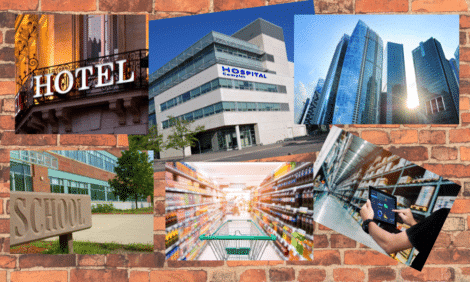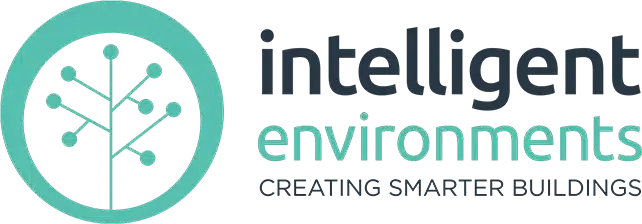The term “commercial buildings” refers to structures used primarily for business purposes.
These buildings are designed to support various commercial activities, such as retail, office work, hospitality, and industrial functions.
Lighting control for commercial buildings is usually considered essential but will include two elements: the base building (the shared spaces such as entry, lift lobbies, corridors, fire exits, etc.) and the tenants’ areas (such as offices, warehouses, retail areas, etc).

Commercial Buildings Include:
Office Buildings: Structures used for business operations, such as corporate offices, law firms, tech companies, and government agencies. These range from small single-tenant buildings to large high-rise office complexes.
Retail Buildings: Spaces designed for selling goods and services, including shopping malls, supermarkets, speciality stores, and standalone retail shops.
Industrial Buildings: These include warehouses, manufacturing plants, distribution centres, and research facilities, where products are created, stored, or shipped.
Hospitality Buildings: Hotels, resorts, and restaurants are included in this category, as they provide services related to accommodation, food, and leisure.
Healthcare Buildings: Hospitals, clinics, and medical centres are also considered commercial buildings, as they provide healthcare services to the public.
Entertainment and Recreation Facilities: Theatres, cinemas, fitness centres, and sports arenas are also classified as commercial buildings, as they are used to generate revenue through entertainment and recreational activities.
Multi-Use or Mixed-Use Buildings: These buildings combine different functions, such as retail, office space, and residential units, all in one structure.
In essence, any building that generates income through the provision of goods, services, or commercial activities falls under the umbrella of “commercial buildings.”
BASE BUILD
In the construction world, the term “Base Build” refers to the foundational work done by the developer to create the essential structure of a commercial building. This includes the core components such as the primary framework, building envelope (roof, façade), and key mechanical systems like power, HVAC, and water supply.
Once tenants move in, they or the developer will handle further customisations to suit their needs — this is known as the tenancy fit-out.
Lighting Control in Shared Spaces
One critical aspect of the base build is lighting control, especially in shared spaces like car parks, entryways, and fire exits.
Unfortunately, the emphasis on cost-saving often leads to developers opting for the cheapest lighting and control solutions, which may work initially but have high failure rates. When considered as cost/length of life, these “cheap” systems usually work out more expensive, and result in even greater expenses down the line.
The Pitfalls of “Cheap” Lighting Control for Commercial Buildings
When a base build lighting control system is chosen based on cost alone, are you compromising on quality? While such cheap systems may comply with basic functionality requirements, they rarely offer the flexibility needed to adapt to evolving tenant needs.
For instance, cheaper systems often lead to complications with warranties, especially when paperwork is lost, or the subsequent building owner had no involvement in the purchase decisions. These low-cost solutions may also lack manufacturer support, leaving building owners with high maintenance costs once the system starts to fail.
Even when lighting products and control systems are specified with care and due diligence, cost-cutting during construction can lead to substitution with lower-quality alternatives. Although these decisions might save money initially, they create long-term challenges for building owners and tenants, as system failures become more frequent, and replacement costs grow.
Building for Sustainability
In today’s world, where sustainability is increasingly critical, developers must focus on solutions that reduce waste and carbon footprints. Instead of opting for low-cost systems that might need to be replaced in a few years, they should consider lighting control systems designed for longevity and scalability.
A key part of sustainable construction is choosing products that not only function well now but adapt to future demands.
“Budget” will always be a major factor in the purchasing decision, but when deciding on lighting control for a commercial building, it makes sense to choose a base build system that fits within budgetary constraints, but also can evolve and/or expand to meet the changing needs of the building and its tenants over years to come.
DALI-2: Low-Cost Now, Expandable Later
The DALI-2 standard for lighting control offers a low-cost solution that complies with the AU/NZ lighting control standards.
It can provide the basic functionality required in the initial stages, but the system can designed to grow with the building’s needs. It can be expanded simply and cost-effectively to support more advanced functionalities, such as remote system monitoring, building analytics, and energy reporting.
As DALI-2, with the appropriate software, allows for two-way communication between sensors, switches, and lights, it means the system can report on energy usage, individual lamp performance, and even potential system failures. This level of insight helps with maintenance and supports better buying decisions by providing actual data on how long lamps last compared to their manufacturer’s claims.
The DALI-2 system can provide control, with monitoring and reporting on both the standard lighting system, and the emergency lights.
An additional benefit of a DALI-2 emergency system is that it tracks the status of connected emergency luminaires and their batteries. Testing and reporting can be automated. This data is invaluable for ensuring compliance with safety standards and reducing maintenance costs.
Moreover, using the DALI-2 open protocol ensures the system complies with New Zealand’s lighting control standards and offers third-party tested and certified products. This is the smart way to balance budget and sustainability in commercial construction projects.
Talk to us about lighting control for commercial buildings and we can explain how it’s possible to deliver a base build system that meets both financial and sustainability goals while providing a futureproof framework for later expansion.
TENANCY FITOUTS
Lighting Control for Tenancy Fit-outs: Creating Flexible, Energy-efficient Spaces
Tenancy fit-outs are the second phase in commercial building where individual spaces are customised to meet the needs of the tenants who occupy them.
This typically involves the interior design, layout, and technology systems such as lighting, HVAC, and communications. While the base build includes core infrastructure like power supply and basic lighting for common areas, tenancy fit-outs focus on adapting individual spaces to meet specific requirements.
For lighting control, this means creating a system that not only suits the tenant’s immediate needs but is also flexible enough to evolve as their business grows or their operational needs change.
If sensible choices have been made for the Base Build, the lighting control for any tenancies will be an easy and seamless addition.
The Importance of Flexible Lighting Control
Lighting is much more than just illumination; it impacts employee productivity, customer experience, and overall energy costs. In tenancy fit-outs, it is essential to install a lighting control system that provides flexibility, efficiency, and ease of use.
Key Considerations for Lighting Control in Tenancy Fit-Outs:
-
- Customisable Design: Tenants often have varying needs based on their industry, the layout of their space, and how they use it. An office may require task lighting with dimmable controls, while a retail store may need dynamic lighting to enhance product displays. A flexible lighting control system allows tenants to tailor the lighting in different zones to suit their unique requirements.
- Energy Efficiency: Commercial tenants are increasingly focused on sustainability and reducing energy costs. Lighting control systems that incorporate sensors, timers, and dimming capabilities can significantly cut down on energy consumption by automatically adjusting lighting based on occupancy and daylight availability. These systems ensure that lights are only on when needed, which lowers utility bills and supports sustainability goals.
- Smart Integration: Modern lighting control systems can integrate with building management systems (BMS) and smart building technologies. For tenants in fit-outs, this means they can connect their lighting controls with HVAC, security, audio-visual, and other systems for greater efficiency and convenience. For example, lights can be programmed to turn on and off in sync with HVAC, or respond to motion detectors to optimise energy use.
- Scalability: A well-designed lighting control system should be scalable, allowing tenants to expand or reconfigure their lighting setup as their needs change. This is particularly important for growing businesses, where future expansions may require additional lighting zones or enhanced control capabilities.
DALI-2 for Tenancy Fit-outs: A Smart Solution
One of the best solutions for tenancy fit-outs is the DALI-2 (wired) or DALI+ (wireless) lighting control system. DALI is a global standard for digital lighting control that ensures interoperability between different lighting devices and systems. It offers tenants several key benefits:
• Zoning Flexibility: Tenants can create custom lighting zones to control different areas of their space independently, ensuring that lighting can be tailored to specific activities or tasks.
• Energy Savings: DALI-2 systems support occupancy and daylight sensors, enabling automatic adjustments to lighting based on real-time conditions.
• Scalability: As the tenant’s business grows, DALI-2 allows for easy expansion of the system without having to replace the existing infrastructure.
• Data Insights: The system provides detailed data on energy usage and system performance, allowing tenants to track efficiency and identify areas for improvement.
• Emergency Lighting Integration: DALI-2 systems also offer integrated emergency lighting solutions, ensuring compliance with safety regulations and providing peace of mind for tenants.
Tenant-friendly Features
The modern workplace requires lighting control systems that offer user-friendly interfaces and simple control options.
The zencontrol DALI-2 or DALI+ systems that we provide can include:
– Wall-mounted control panels: These allow tenants to manually adjust the lighting settings in real-time or provide pre-set scenes for different moods or tasks.
– Mobile apps or desktop dashboards: These enable remote control of the lighting system, allowing tenants to make adjustments even when they’re offsite. Dashboards also provide insights into energy consumption and system performance.
– Automation: Tenants can schedule their lighting to automatically adjust based on time of day, occupancy, or sunlight levels, making it easy to maintain the perfect lighting environment without constant manual control.
Supporting Tenant Comfort and Productivity
In addition to energy efficiency and flexibility, lighting control systems in tenancy fit-outs are crucial for creating a comfortable and productive environment. Proper lighting design can reduce eye strain, improve focus, and create an inviting atmosphere for both employees and visitors. For instance, tuneable white lighting systems can adjust the colour temperature throughout the day to mimic natural light, enhancing occupant well-being and maintaining a productive work environment.
Conclusion
A well-designed lighting control system for tenancy fit-outs is essential for creating areas that are efficient, flexible, and comfortable for everyone using the space.
By choosing scalable solutions like DALI-2 and DALI+, building owners and tenants can invest in lighting control systems that not only meet current needs but are also ready to grow and evolve with the business.
This approach not only supports tenant satisfaction and productivity but also contributes to energy savings and sustainability, making it a win-win solution for all parties involved.
When it comes to the base build lighting control for commercial buildings, developers need to move beyond immediate cost-saving measures and look at solutions that deliver value over the long term.
By choosing systems like DALI-2/DALI+ that are both budget-friendly and adaptable, developers can provide buildings that comply with current standards and are not only functional today but also future-ready.
After all, it’s not just about building for today — it’s about building for tomorrow.
If you are looking at lighting control for commercial buildings, whether for base-build or for tenancy fit-outs, get in touch for a free consultation, New Zealand wide.


